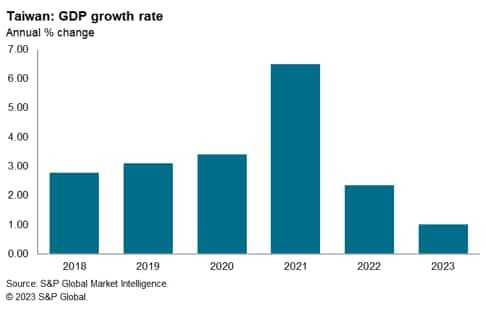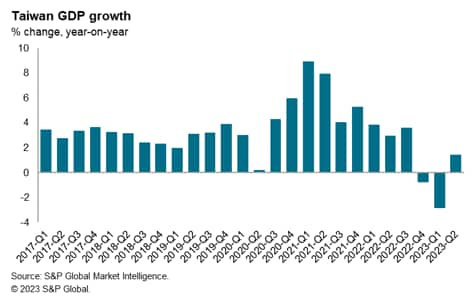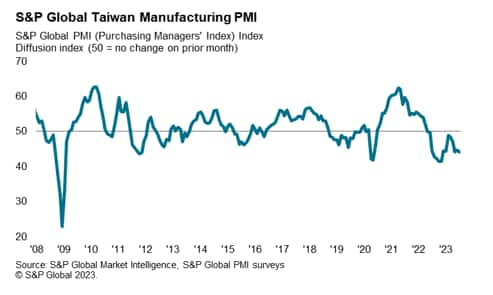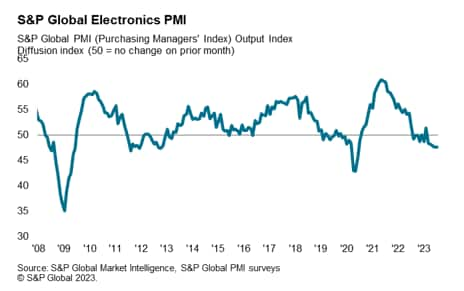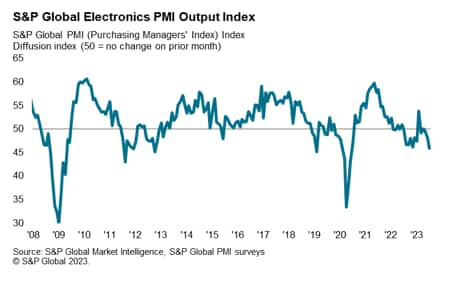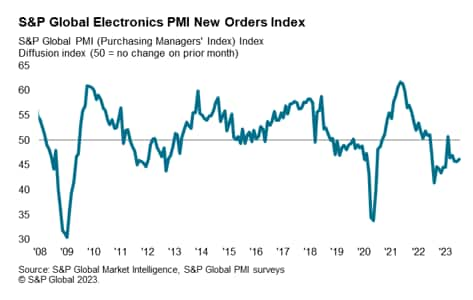Customer Logins
Obtain the data you need to make the most informed decisions by accessing our extensive portfolio of information, analytics, and expertise. Sign in to the product or service center of your choice.
Customer Logins
ECONOMICS COMMENTARY
Aug 11, 2023
Taiwan economy rebounds in second quarter of 2023
Taiwan's emerged out of technical recession in the second quarter of 2023, with GDP growth of 1.7% quarter-on-quarter (q/q) after two successive quarters of GDP contraction. The rebound was driven by private consumption, which grew by 12.1% year-on-year (y/y) in the second quarter of 2023.
However the export sector has continued to be hit by slumping exports, which fell by 6.6% y/y in the second quarter of 2023. The net impact on GDP was mitigated by a sharp decline in imports, which fell by 7.7% y/y. A key factor driving the export slowdown has been weak demand for Taiwan's electronics exports in key global markets, notably the US, EU and mainland China. The latest S&P Global Taiwan Manufacturing Purchasing Managers' Index (PMI) reading was at 44.1 in July, still indicating contractionary conditions for Taiwan's manufacturing sector during the second half of 2023.
Taiwan's exports continue to slump
Taiwan's economy rebounded in the second quarter of 2023, returning to growth after having recorded two successive quarters of negative growth. Consequently, Taiwan's technical recession that ran from the fourth quarter of 2022 until the first quarter of 2023 ended in the second quarter of 2023, primarily due to the strength of private consumption spending growth.
Taiwan's growth slowdown follows a period of strong economic expansion in 2021 and 2022. In 2021, annual GDP rose by 6.5 percent y/y. This was the fastest pace of annual economic growth since 2010, boosted by export growth of 29% y/y, with exports of semiconductors up by 27% y/y.
This was followed by continued positive GDP growth at a pace of 2.4% in calendar 2022, helped by strong global demand for electronics exports during most of 2022. Taiwan's merchandise exports rose by 7.4% y/y in 2022, buoyed by strong expansion in exports of electronics components, which rose by 16.4% y/y, while semiconductors exports rose by 18.4% y/y.
However, since mid-2022, Taiwan's electronics sector exports, which are a key export, have weakened significantly, due to slumping electronics demand in the US, EU and mainland China. The downturn in Taiwan's exports has been a key factor contributing to its economic slowdown.
Taiwan's exports have remained weak during the first seven months of 2023, with merchandise exports in July 2023 contracting by 10.4% y/y, after an even sharper downturn of 23.4% y/y in June. In the first seven months of 2023, Taiwan's exports fell by 16.9% y/y.
Exports to mainland China and Hong Kong SAR declined by 16.3% y/y in July, after contracting by 22.2% y/y in June. Mainland China and Hong Kong SAR remained the largest export market and accounted for 34.6% of Taiwan's total exports in July.
In July, Taiwan's exports to ASEAN fell by 8.4% y/y, while exports to the US declined by 3.3% y/y. Exports to Europe performed strongly, rising by 24% y/y due to higher exports of ICT products.
Taiwan's manufacturing sector business conditions have remained weak in mid-2023. Industrial production fell by 16.6% y/y in June, with manufacturing output down by 17.2% y/y.
At 44.1 in July, the S&P Global Taiwan Manufacturing PMI slipped from 44.8 in June and signalled a deterioration in the health of the sector for the fourteenth consecutive month. The pace of decline was the sharpest recorded since November 2022 and among the steepest since the survey began in April 2004. A key factor pushing the headline index lower in July was an accelerated fall in manufacturing production. Output has now been scaled back in each of the past 16 months, with the latest reduction the quickest seen since January.
Total new business likewise fell at the fastest rate since January and rapidly overall. Panel members noted lower sales across both domestic and external client bases. Notably, new export business contracted at the steepest rate for six months, with firms commenting on reduced demand across a variety of markets, including Europe, Japan, mainland China and the US.
Weak demand and improved material availability led to a further drop in average input costs during July. Input prices fell at a solid pace that was the second sharpest since May 2020. Notably, selling prices were cut at the quickest pace in just over three years.
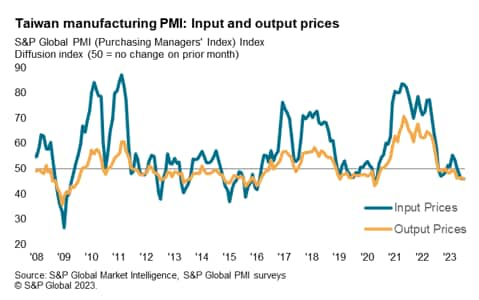
Taiwan's CPI inflation rate moderated to 1.9% y/y in July 2023, while core CPI excluding energy and food rose by 2.7% y/y, indicating retail inflationary pressures remain contained. Although inflation has been moderating in recent months, Taiwan's central bank raised its policy rate by 12.5 basis points (bps) on 23 March 2023 in order to limit potential further inflation pressures, after having acted pre-emptively during 2022 with a series of modest tightening steps to contain inflation pressures.
The central bank started its tightening cycle in March 2022, with its tightening step of 25bps having been the first rate hike since June 2011. The previous most recent change to policy rates had been a rate cut in March 2020 in response to the global COVID-19 pandemic. The March 2022 rate hike was followed by a 12.5 bps increase in June 2022, a 12.5 bps hike in September 2022 and another 12.5 bps in December 2022.
Global headwinds facing electronics industry
In July 2023, Taiwan's exports of electronics products fell by 7.9% y/y. Despite the significant contraction, the July outturn showed a less severe decline compared with the 21.3% y/y fall in exports in June.
The downturn in Taiwan's ICT exports reflects the slowdown in the global electronics industry since mid-2022. The headline seasonally adjusted Electronics PMI was at 47.6 in July, signalling continued contraction in operating conditions across the global electronics manufacturing sector for the fifth consecutive month. A solid decline in order book volumes contributed to the sharpest fall in output since June 2020. While demand conditions were muted, firms took the opportunity to clear outstanding work, as backlogs of work fell by the greatest extent since May 2020.
At the same time, electronics goods producers signalled an acceleration in input price pressures for the first time since last September, with the latest round of input price inflation the strongest for three months.
Global electronics manufacturers recorded a sustained contraction in output at the start of the third quarter of the year. The downturn was sharp, and the strongest recorded since June 2020.
New orders placed with global electronics producers fell for the fifth month in a row during July. The New Orders index continued to reflect contractionary conditions with a sub-50 reading and was often attributed by panellists to weak demand conditions in the US, Europe and China due to general economic weakness and market uncertainty.
Economic outlook
After rapid economic growth in 2021 and continued firm expansion in 2022, Taiwan's economy has moderated in 2023, mainly due to the downturn in exports. This reflects continued weakness in key markets for Taiwan's electronics exports, notably the US, EU and mainland China. Taiwan's export orders fell by 24.9% y/y in June 2023, signalling continued near-term weakness for the manufacturing export sector.
Taiwan's medium-term outlook remains for sustained positive expansion at a moderate pace, underpinned by improving global electronics demand during 2024 and 2025. The impact of the COVID-19 pandemic has accelerated the pace of digital transformation due to the global shift to working remotely, which has boosted demand for electronic devices such as computers, printers and mobile phones.
The medium-term outlook for electronics demand is underpinned by major technological developments, including 5G rollout over the next five years, which will drive demand for 5G mobile phones. Demand for industrial electronics is also expected to grow rapidly over the medium term, helped by Industry 4.0, as industrial automation and the Internet of Things boosts rapidly growth in demand for industrial electronics. Taiwan's electronics industry will continue to benefit from its leading role in production of advanced semiconductors as well as from its production of a wide range of other electronics products for consumer and industrial electronics.
Access the Taiwan Manufacturing PMI press release here.
Rajiv Biswas, Asia Pacific Chief Economist, S&P Global Market Intelligence
Rajiv.biswas@spglobal.com
© 2023, S&P Global. All rights reserved. Reproduction in whole
or in part without permission is prohibited.
Purchasing Managers' Index™ (PMI®) data are compiled by S&P Global for more than 40 economies worldwide. The monthly data are derived from surveys of senior executives at private sector companies, and are available only via subscription. The PMI dataset features a headline number, which indicates the overall health of an economy, and sub-indices, which provide insights into other key economic drivers such as GDP, inflation, exports, capacity utilization, employment and inventories. The PMI data are used by financial and corporate professionals to better understand where economies and markets are headed, and to uncover opportunities.
This article was published by S&P Global Market Intelligence and not by S&P Global Ratings, which is a separately managed division of S&P Global.
{"items" : [
{"name":"share","enabled":true,"desc":"<strong>Share</strong>","mobdesc":"Share","options":[ {"name":"facebook","url":"https://www.facebook.com/sharer.php?u=http%3a%2f%2fwww.spglobal.com%2fmarketintelligence%2fen%2fmi%2fresearch-analysis%2ftaiwan-economy-rebounds-in-second-quarter-of-2023.html","enabled":true},{"name":"twitter","url":"https://twitter.com/intent/tweet?url=http%3a%2f%2fwww.spglobal.com%2fmarketintelligence%2fen%2fmi%2fresearch-analysis%2ftaiwan-economy-rebounds-in-second-quarter-of-2023.html&text=Taiwan+economy+rebounds+in+second+quarter+of+2023+%7c+S%26P+Global+","enabled":true},{"name":"linkedin","url":"https://www.linkedin.com/sharing/share-offsite/?url=http%3a%2f%2fwww.spglobal.com%2fmarketintelligence%2fen%2fmi%2fresearch-analysis%2ftaiwan-economy-rebounds-in-second-quarter-of-2023.html","enabled":true},{"name":"email","url":"?subject=Taiwan economy rebounds in second quarter of 2023 | S&P Global &body=http%3a%2f%2fwww.spglobal.com%2fmarketintelligence%2fen%2fmi%2fresearch-analysis%2ftaiwan-economy-rebounds-in-second-quarter-of-2023.html","enabled":true},{"name":"whatsapp","url":"https://api.whatsapp.com/send?text=Taiwan+economy+rebounds+in+second+quarter+of+2023+%7c+S%26P+Global+ http%3a%2f%2fwww.spglobal.com%2fmarketintelligence%2fen%2fmi%2fresearch-analysis%2ftaiwan-economy-rebounds-in-second-quarter-of-2023.html","enabled":true}]}, {"name":"rtt","enabled":true,"mobdesc":"Top"}
]}





